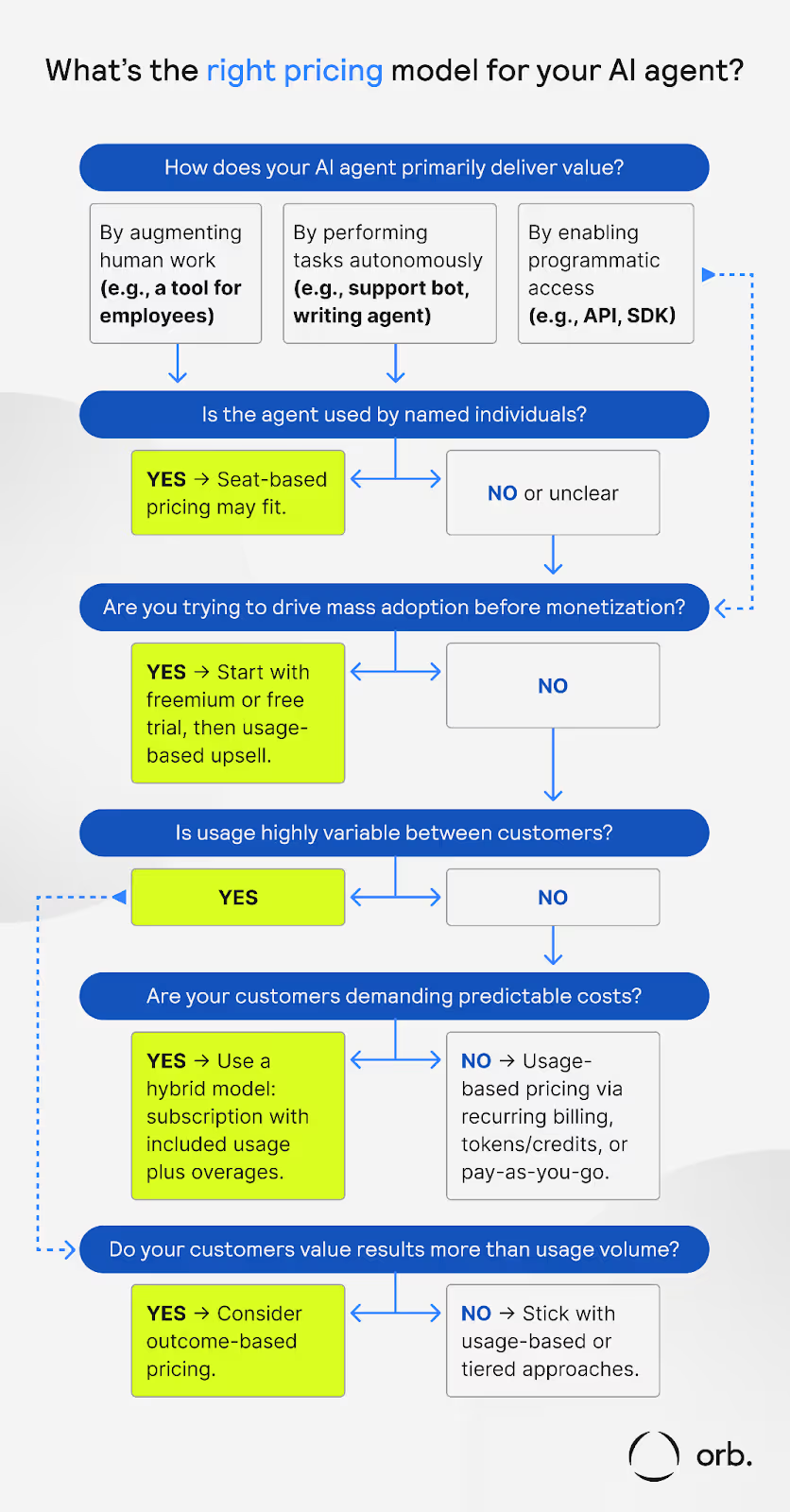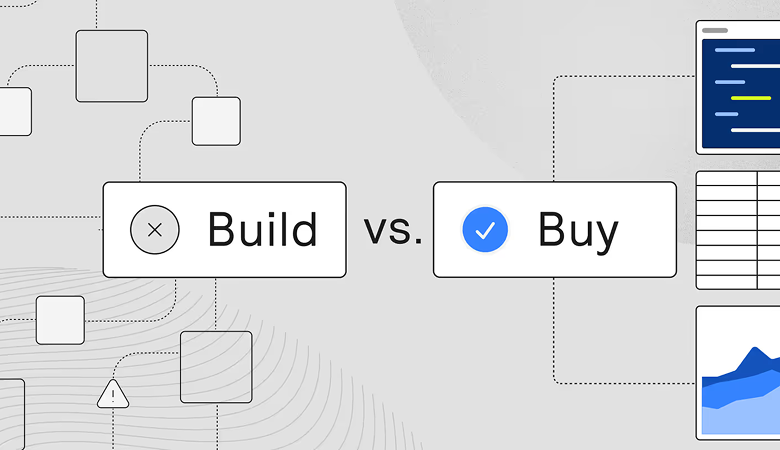In GenAI, success can be financially painful. Every prompt sent, image generated, or API call fulfilled delivers value to your customer. However, each interaction also incurs compute costs in real time. The more your product is used, the more it costs you to run. This is the AI pricing paradox: growth isn’t just an opportunity; it can be a liability.
Traditional SaaS pricing breaks under this pressure. Pricing per seat or flat-rate subscriptions can’t keep pace with usage that varies wildly between customers, or within a single customer over time. While usage-based pricing addresses this issue and has gained traction among AI companies, it may not be the right fit for every product.
“In SaaS, high usage is a victory; in GenAI, high usage without the right pricing model can become a liability.”
— Pricing AI Agents
Choosing the right pricing model is a strategic lever that affects product design, infrastructure planning, and customer satisfaction. The right model strikes a balance between value capture, cost recovery, and user alignment, but there’s no one-size-fits-all answer.
At Orb, we’ve helped some of the fastest-growing SaaS and GenAI companies navigate this puzzle. We’ve seen what works, what doesn’t, and why the difference often comes down to nuance. In this post, we’ll walk through a framework to help you find the right path for your business.
Introducing the AI agent pricing decision tree
Pricing AI products isn’t just about what customers do; it’s about how that behavior affects your revenue, margins, and scalability. At Orb, we’ve seen that the most successful monetization strategies start with a few foundational questions that map product usage to financial outcomes.
We’ve captured those insights in a visual decision tree that guides you toward a strong pricing starting point, as well as a brief explanation of the key things that determine which pricing model is the right fit.

How your product delivers value
- Human-augmenting tools (e.g., copilots, assistants): These agents are used by employees, helping them be more productive and efficient in their work. Per-seat pricing fits well here, since value scales as more employees use the product and usage is predictable across individuals. It also simplifies packaging and forecasting.
- Autonomous agents (e.g., support bots, writing tools): These agents replace human labor, so pricing should reflect the value of that work. While humans need to be involved in the initial setup, the agent then operates on its own. This can be done by charging per task or outcome, allowing you to align incentives and protect profit margins.
- APIs and infrastructure: Products that allow agents to access data or execute what they’re designed to do should consider usage-based pricing because it captures both customer value and backend costs as usage increases.
Who the end user is
- Named individuals: Seat-based pricing gives you predictability and allows easy upsell as organizations scale.
- Broad or anonymous usage: When agents aren’t used by specific individuals but by large groups of people (e.g., consumers) or anyone, charging per seat breaks down and fails to scale your revenue. Instead, usage-based or hybrid pricing helps you increase revenue over time while keeping upfront costs low.
Whether usage is consistent or highly variable
- Predictable usage: Because your costs will also be pretty stable, subscription pricing can work while also delivering revenue stability and keeping billing simple.
- Highly variable usage: Usage-based pricing protects your margins by tying revenue to real-time costs, avoiding over- or undercharging across customer segments.
Whether customers value outcomes or access
- Outcome-driven use cases: Pricing per result (e.g., leads, answers, solved tickets) aligns your product with what customers care about, builds trust, and enables you to capture more value when your product performs effectively.
- Access- or volume-driven use cases: Charging by API call, token, or compute time creates a clean link between customer engagement and your costs, which is critical for AI products with variable workloads.
Choosing the right pricing model: Options and decision factors
Your pricing model is one of your most strategic levers. It defines how you capture value, control costs, and shape user behavior. Get it wrong and you risk subsidizing power users, confusing your buyers, or leaving money on the table.
Here’s a breakdown of the most common pricing models, including when they shine, where they break down, and how to choose one that fits your product’s DNA.
Usage-based pricing
This model charges customers based on how much they use the product. For example, tokens consumed, API calls made, or content generated.
- Strengths: Ideal when usage directly reflects customer value. Revenue scales with compute costs so that profit margins are protected, making it a popular choice for infrastructure and API-based products.
- Challenges: It can spook customers who want billing predictability and requires strong billing transparency to be trusted by customers.
- Best for: APIs, developer tools, and infrastructure components where usage equals value.
Freemium or free trial
Offering free access to part of your product is a proven way to encourage mass adoption. The key is to convert engaged users into paid customers once they hit usage thresholds or experience enough value.
- Strengths: Lowers the barrier to entry, drives viral growth, and reveals product-market fit through real usage.
- Challenges: Supporting free users incurs real costs, especially with high compute workloads. Conversion needs to be tightly measured and optimized.
- Best for: Developer tools, PLG (product-led growth) products, and viral GenAI apps looking to build momentum.
Seat-based pricing
Charging by users or seats works well when your AI agent is used to enhance individual productivity. Examples of this are coding assistants or customer service tools. Seat-based pricing is familiar to most B2B buyers since it’s the typical pricing model used for SaaS.
- Strengths: Familiar to buyers and easy to budget for.
- Challenges: Risks under-monetizing heavy users unless usage is capped. Does not directly align revenue with compute costs.
- Best for: Copilot-style tools.
Hybrid models
A hybrid approach combines elements of different pricing models. Oftentimes it combines models that provide predictable recurring revenue with those that provide variable revenue. For example, flat-rate subscriptions that include a set number of queries or API calls with additional usage billed at a separate rate.
- Strengths: Offers predictable costs upfront while capturing additional revenue for overages. Protects margins while accommodating different user behaviors.
- Challenges: It may be complex to communicate thresholds or overage rules, and requires good UX to avoid confusion or churn.
- Best for: Products with wide usage variance (e.g., Adobe Firefly, APIs).
Outcome-based pricing
With this model, you charge customers based on specific results. This can include metrics such as leads generated, conversations completed, or tasks automated.
- Strengths: Aligns perfectly with customer ROI, making value crystal clear. Justifies premium pricing.
- Challenges: Requires bulletproof tracking and agreement on what counts as success. Trust becomes a key currency.
- Best for: Agents replacing clear human labor, like sales development reps, support agents, or task automation bots.
“Scaling an AI agent without scalable pricing is dangerous.”
— Pricing AI Agents
Factors that shape your decision
No pricing model works in isolation. Your pricing strategy should reflect your product’s economics, customer psychology, and business objectives.
- Cost structure: Are your infrastructure and compute costs predictable or variable?
- Customer preferences: Do your buyers value price predictability or prefer paying for what they use?
- Product maturity: Do you have the data to understand usage patterns, or are you still exploring?
- Revenue strategy: Are you optimizing for land-and-expand growth, or aiming for high average customer value (ACV) out of the gate?
Putting it all together
Pricing is no longer set it and forget it. It’s a strategic decision and growth lever.
While this framework simplifies the decision-making process that goes into pricing, it serves as a good starting point for some of the questions that you should consider. It also shouldn’t be seen as a rigid rulebook. Pricing should evolve as your product evolves and the market shifts. Static pricing leaves you exposed to shrinking margins, broken incentives, and missed opportunities.
But in order to do this, you need flexible infrastructure that enables pricing agility while maintaining billing stability. That’s where Orb comes in.
Orb was purpose-built for this kind of pricing evolution. By ingesting raw event data and decoupling pricing logic from usage data, Orb gives you the flexibility to support any pricing model, from usage-based to outcome-based, and change it on the fly without touching your codebase. As pricing shifts, your invoices stay precise due to Orb’s raw event architecture.
With Orb Simulations, you can even forecast the impact of new pricing models using historical data before you launch. This decreases the risk of introducing new pricing, as you’re able to see how it impacts revenue and usage.
It’s pricing, billing, and reporting, done your way. In a category moving this fast, that’s not a luxury. It’s a requirement.
Learn how Orb empowers AI companies to find the right pricing model with fast, safe experimentation.



